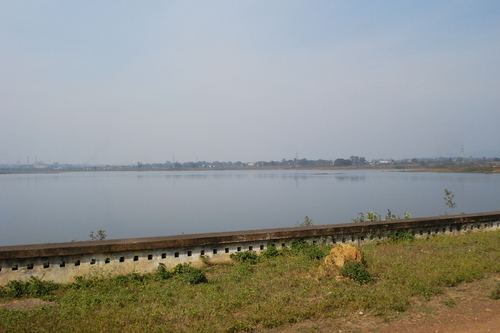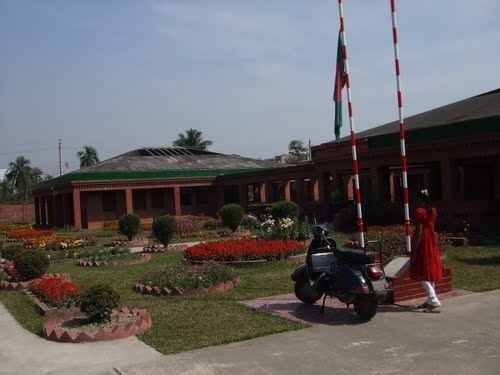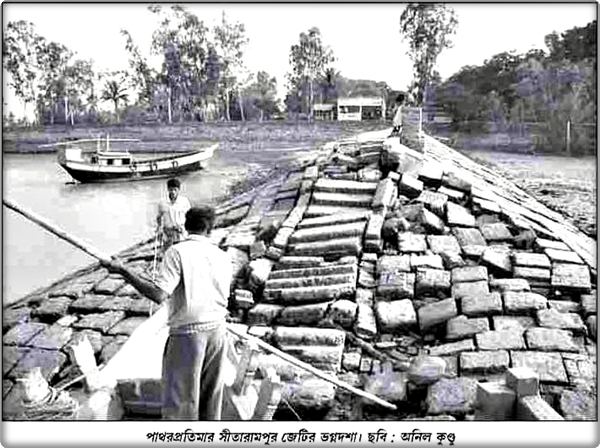Country State | District Barddhaman | |
 | ||
Languages spoken Bengali, English | ||
Map of Sitarampur
Sitarampur, is the Western neighbourhood in Asansol, in Asansol Sadar subdivision of Paschim Bardhaman district in the Indian state of West Bengal. It was one of the early hubs of coal mining activity. Coal was found in abundance around Sitarampur in the early years of the 19th century and mining started at this place in a big way.
Contents
- Map of Sitarampur
- Durga puja 2009 asansol sitarampur opposite to post office part i
- Sitarampur nazira
- Geography
- Asansol Municipal Corporation
- Coal mines
- Mines safety
- Language
- Economy
- Educational institutions
- Transport
- References

Durga puja 2009 asansol sitarampur opposite to post office part i
Sitarampur nazira
Geography

Sitarampur is located at 23.72°N 86.88°E / 23.72; 86.88. It has an average elevation of 100 m (330 ft).
Asansol is composed of undulating latterite soil. This area lies between two mighty rivers – the Damodar and the Ajay. They flow almost parallel to each other in the region – the average distance between the two rivers is around 30 km. For ages the area was heavily forested and infested with plunderers and marauders. The discovery of coal led to industrialisation of the area and most of the forests have been cleared. At the western fringe of the area the Barakar forms the boundary with Jharkhand.
Asansol Municipal Corporation
According to the Kolkata Gazette notification of 3 June 2015, the municipal areas of Kulti, Raniganj and Jamuria were included within the jurisdiction of Asansol Municipal Corporation.
Coal mines
Coal in India was first discovered around Sitarampur. The early mines were Baro Dhemo and Sundarchak. Those mines are now defunct and they were closed about eighty years ago after being in operation for about seventy odd years. As those mines started to dry up, new virgin plots were excavated, some of which extended beyond the Damodar River into Purulia district and beyond River Barakar into the Nirsa of Dhanbad district in Jharkhand.
One of the deepest mines in Asia, Chinakuri 1 and 2, is located in this region. It is situated 1.2 miles (1.9 km) below the surface and inclines under the Damodar River extending for some 3.5 miles (5.6 km) into Purulia district. This mine boasts of a regular underground train service to ferry workers from the mine shaft to the coal face.
Mines safety
With hectic operations in the mines, accidents occurred frequently leading to loss of life. The government felt the need to regulate the mining process. Directorate of Mines Safety was set up for this purpose. It inspected the mining procedure with firm laws and imposed hard penalties for non-compliance. It resulted in a strong control on accidents and loss of life was reduced. Presently, the zonal office of the Directorate General of Mines Safety is located at Sitarampur.
However, the mining community could not tackle the onslaught of nature, which came in the form of rain and floods. Mines were flooded and people got trapped inside. So a force was formed to help in rescue operations. The Mines Rescue Station was formed at Sitarampur and the mining community was taught what to do in such situations. Being an old mining area it was a pioneer in many fields. The ideas subsequently spread to other areas. Currently, six main rescue stations and eighteen rescue rooms with refresher training facilities have been established and are functioning in various subsidiaries of Coal India Limited.
A small captive explosive manufacturing factory was established at Sitarampur for the supply of dynamite for solid blasting in open cast mines. The unit was in operation from around 1914 to 1935. The reason for the closure of this unit was the supply of dynamite to the revolutionaries who created hell for the ruling British. The authorities relocated the unit at various places far from the mining region and supply was strictly regulated.
Language
It mainly consists of Bengali, Gujarati, Marwari, and Hindi-speaking people from Bihar and Jharkhand.Bengali is official language in Sitarampur.
Economy
Sitarampur is mainly a coal-mining centre, hence many people in Sitarampur and Neamatpur work in the various Coal Mines of Eastern Coalfields Limited. Some People also work in the Office of the Directorate General of Mines Safety and in the Indian Railways. Most of the Marwaris in the town are involved in some Business or the other. Nearest police station is Neamatpur Investigation Centre.
Collieries in the Sitarampur Area of Eastern Coalfields are: Mithani, Bejdi, Dhemomain, Narsamuda, BC Incline and Patmohana.
Educational institutions
The Belrui N.G. Institution,N.D.Rashtriya Vidyalaya(HS) and Jaladhi Kumari Devi uchcha Balika Bidyalaya are the three most renowned schools in and around Sitarampur. These two schools have produced many board exam Toppers in the Asansol subdivision. The Nearest English Medium Schools are [Priyadarshini Public School, St. Patricks High School, St. Vincents School,and Loreto Convent in Asansol and The Assembly of God Church School at Sodepur. Higher Education facilities like Colleges are not available and one has to go to Asansol or some other town in the state or outside the state.
In this connection Tagore Institute of Sitarampur deserves special mention, as it marks a landmark of the place, although it now stands in a desolate and dilapidated condition in the western end of the Railway playground. The Tagore Institute was in the past a hub of cultural activities, and dramatic performances and cinema shows used to be staged on festival seasons. Seasonal games of football and cricket were played in the playground on regular basis. By the psychological law of association the name of Akhil Memorial Challenge Shield (Now defunct)comes to mind. Durgapuja is held here on a permanent structure erected close to Tagore Institute,for continuous 74th year There is another playground nearby called "Paltandanga" where circus and sporting activities like cycle race used to be held during winter months. Incidentally, during the Second World War large platoons of American and British soldiers used to set up tents for sojourn in "Paltandanga", hence the name of the ground, in Bengali 'paltan' being the corrupt and distorted form of English word 'platoon'.
During the great war Belrui school was used as a temporary storehouse of foodgrains for buffer stock, and classes remained suspended for a pretty long time. Then there is Railway Vidyapith (Primary School) founded in 1954 close to the Rly health centre, which has been subsequently upgraded up to class VIII. As a result of steady expansion of population and urban agglomarization new colony has come up in the area which was previously known as loco colony towards Asansol.
Now Asansol has an engineering college, which also runs certificate courses. This college is located on the national highway(NH-19).
Transport
As movement of coal by trains increased considerably a new railway line, the Grand Chord, was laid from Sitarampur to Mughalsarai. At that time, Sitarampur railway station boasted of the largest steam locomotive shed and the second largest coal moving yard in the country. Now the steam loco shed is gone as steam engines were phased out.
The Howrah-Delhi rail track separates into the Main and Grand Chord lines at Sitarampur and rejoins at Mughalsarai. Hence many important trains on the Howrah - Delhi passes through and have stoppages at Sitarampur.
Some major trains providing stoppage at Sitarampur are Dhanbad - Howrah Coalfield Express and Black Diamond Express, Kathgodum Express, Mithila Express etc. Many local and passenger trains connect Sitarampur with Dhanbad, Gomoh, Chittaranjan, Asansol and Bardhaman and to Madhupur and Deoghar in Deoghar district of Jharkhand and various other parts of Jharkhand and Bihar.
Road connectivity to Sitarampur is provided through the Grand Trunk Road which passes through the adjacent town of Neamatpur. One can go to Kolkata, Durgapur, Barakar and Dhanbad easily travelling by the Grand Trunk Road. One can also go to Purulia via Dishergarh and to Chittaranjan after reaching the Grand Trunk Road at Neamatpur.
Regular Minibus services are available from Asansol City Bus Terminus, Barakar, Chittaranjan and Dishergarh. All the mini buses provide a stoppage at Neamatpur. Some Express and Long Distance Government Buses also provide a stoppage at Neamatpur.
